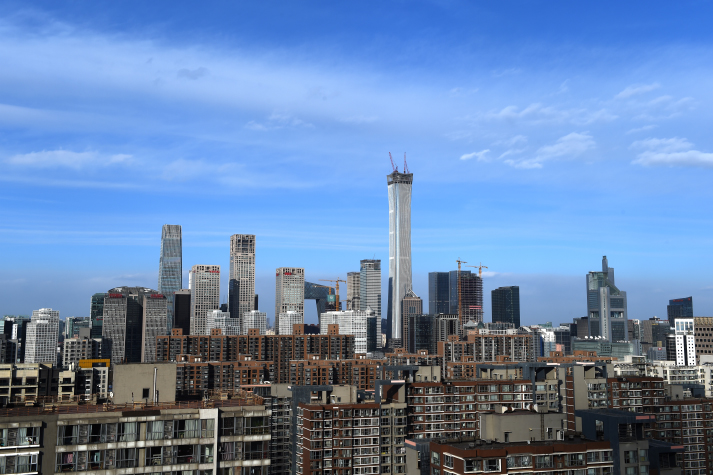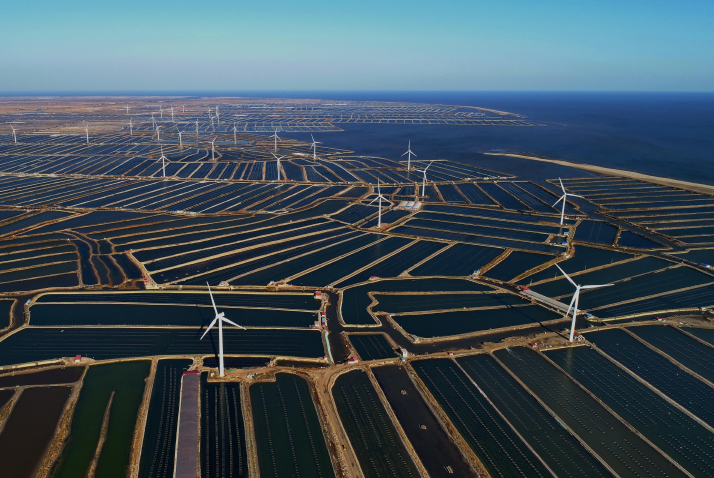|
||||||
|
||||||
| Home Nation World Business Opinion Lifestyle China Focus ChinAfrica Multimedia Columnists Documents Special Reports |
|
||||||
|
||||||
| Home Nation World Business Opinion Lifestyle China Focus ChinAfrica Multimedia Columnists Documents Special Reports |
| Nation |
| A Change in the Air |
| While China takes measures to control pollution, data shows it is a global concern |
| By Craig Crowther and Li Qing | NO.48 NOVEMBER 29, 2018 |
 The CBD area in Beijing on January 22 (XINHUA)
Beijing has experienced significantly cleaner air over the past months. Data from the Beijing Municipal Bureau of Ecology and Environment shows that the concentration of PM2.5, the fine particulate matter in the air, in Beijing during the first 10 months of 2018 stood at 49 micrograms per cubic meter, down 18.3 percent year on year, generating a record low. The capital saw 226 good air days in 2017, 28 days more than in 2016. The number of heavy pollution days decreased by 16 to 23, according to the Beijing environmental protection monitoring center. Despite the improvement in air quality, pollution is still a major concern of the government and its residents. Though the average level of PM2.5 fell to 58 micrograms per cubic meter in 2017 in Beijing, a 27-percent drop compared to 2014-16, according to the research of Smart Air, a social enterprise specializing in producing budget air purifiers, the level still exceeds the healthy limit set by the World Health Organization (WHO). China has taken comprehensive measures, including switching to green energy, to reduce pollution and ward off the ever-present specter of climate change. Making progress The anti-smog campaign is a top priority for the Chinese Government, which focuses on a range of key measures, including reducing industries' reliance on coal, the powerhouse of the burgeoning economy, developing green technologies and overhauling transport infrastructure. By 2020, cities with high levels of PM2.5 are aiming for an 18 percent reduction in average rates, compared with 2015 data. They have also set a goal of ensuring good or moderate air quality for 80 percent of days annually. Last year saw a thorough overhaul and a stricter regulation imposed on the steel industry in the Beijing-Tianjin-Hebei region. Thousands of polluting plants were shut down or their production was restricted. This winter these plants will be permitted to operate so long as they meet emission criteria. There has also been headway in moving toward a clean energy heating system. Heating is one of the drivers of pollution in northern China, which experiences biting cold throughout the winter months. The local government in Shanxi Province has declared that 100 percent of the energy used for heating in 11 of the most built-up areas will be produced by clean sources. By 2020, this should also be in operation in suburban areas. The target for rural areas is 60 percent by 2020. Many provinces have also set absolute limits on coal consumption. For example, Tianjin plans to cap total coal consumption at 40 million tons per annum by 2020, with coal making up less than 45 percent of non-renewable energy consumption. Key companies including those in the petrochemical industry are also highly regulated. Beijing plans to require factories and enterprises which discharge large amounts of pollutants and rely on old technologies to close down. More than 1,000 general manufacturing and polluting enterprises will be affected by this policy by 2020. Transport too is being addressed. Beijing has proposed that by 2020, the number of clean energy vehicles on its streets will reach 400,000 with charging facilities.  A wind power station in Jianggezhuang Town, Laoting County, Tangshan City in north China's Hebei Province, on November 10 (XINHUA)
Green energy The Central Government's three-year plan to win the battle for a blue sky details measures to build a clean, low-carbon and efficient energy system. While China's pollution problem outweighs that of the United States or Europe, China is also the world's largest investor in green technologies. An estimated 2.5 million people are employed in the solar power industry alone, according to a CNN article in 2017 using data from the International Renewable Energy Agency. China is also home to the largest solar power farm in the world. The Tengger Desert Solar Park in Zhongwei City, northwest China's Ningxia Hui Autonomous Region, humorously called the "Great Wall" of solar power, is capable of producing 1,547 MW, indicative of the scale of China's ambitions concerning pollution reduction. Along with authorities' drive to create awareness about pollution, private innovators are contributing by helping to manage people's microenvironment—where they live and work. Masks, air monitors and purifiers are ever present in homes, offices and schools. Smart Air has developed a budget filter that significantly reduces the cost. Paddy Robertson, head of Smart Air in China, told Beijing Review that China is leading the way with regard to monitoring. "China's leading the world in terms of the number of stations and types of pollution they monitor, and numerous companies have popped up to offer low-cost monitoring solutions to governments across the world," Robertson said. "Reliable data and reporting is always the first step to getting a country to take air pollution seriously." Air-quality data reporting started in China 10 years ago. A global issue Tackling pollution is closely linked to reducing carbon emissions and the effects of global warming. An expanding population, a surge in global income and continued industrialization are all aggravating global pollution and the environmental problem. While China is steadily tackling pollution, concerns elsewhere are rising. London Mayor Sadiq Khan has branded his city's air pollution, which regularly exceeds legal levels, a "health crisis." Traffic is the main source of the capital's pollution with diesel cars one of the principal culprits. And the UK is not alone. Auditors from the European Union released a statement in September, criticizing member countries for failing to adhere to stringent targets. The report stated that 23 countries out of 28 are surpassing limits, which could lead to legal action. Smart Air's Robertson said the demand for air purifiers is skyrocketing worldwide, "We get more and more requests from people in Western countries to ship them air purifiers or for an explanation on how to measure air pollution. We get requests from people in the U.S., UK, Australia and even New Zealand." Robertson said while the types of pollution people face in other countries are often different from the pollution in places like China or India, people "are becoming switched on to the fact that the air we breathe—whilst invisible—has a huge impact on our health." According to the WHO, there are 7 million premature deaths globally from pollution, with nine out of 10 children across the planet breathing air categorized as unsafe—a clear indicator that pollution is a common challenge of all countries in the world. Copyedited by Sudeshna Sarkar Comments to liqing@bjreview.com |
About Us | Contact Us | Advertise with Us | Subscribe
|
||
| Copyright Beijing Review All rights reserved 京ICP备08005356号 京公网安备110102005860号 |